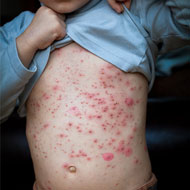How to Deal With Viral Rash in Toddlers
Rashes, infections, allergies are a regular feature in toddlerhood. Viral rashes and infections are in fact a given because your toddler’s immune system is not totally developed.
The good news though, is that by the age of four the immune system is up and running and viral rashes become rare or nonexistent. In the meanwhile, as parents you can keep yourself informed on possible infections and rashes (contagious or otherwise) that your child could possible develop and implement preventive measures accordingly.
What are viral rashes
Viral rashes in the skin are also called erythematous and these as the name suggests are caused by a virus. Typically these rashes are red and inflamed and are accompanied by swelling. These are also usually patches of inflamed skin in different parts of the body. They may or may not be contagious. Most often viral rashes in toddlers aren’t very serious, but you can’t treat them lightly either because these rashes are uncomfortable and at times painful for the toddler. The contagious ones are most difficult because these put your toddler in isolation for several days – a tedious ordeal for both you and your child. More on toddler rashes
Dealing with viral rashes in toddlers
In many cases, there isn’t a specific treatment for the rash itself. The rash disappears once the virus is out of the system. Examples of this type of rash include Chicken pox, measles, cold sores or herpes, strep throat or canker sores. Once the rash sets in, there is no medication for it. But you can get a GP to offer medication for other related ailments that come with like fever perhaps.
These illnesses have a cycle of seven to ten days after which the boils begin to crust and dry out. At best, in the case of chicken pox and measles you can apply some calamine lotion to prevent itching and scarring. The other diseases are usually centered in the mouth, so you can get your toddler to salt water gargle.
Then there are viral rashes like impetigo, prickly heat, yeast infections and scarlet fever, which need some medication. In the case of Impetigo and scarlet fever, depending on the intensity of the rash the doctor may even prescribe anti-biotic medicines. For the other two, i.e. prickly heat and yeast infection, a soothing ointment can do the trick.
As mentioned earlier, these rashes aren’t dangerous. The trick is to spot them early and treat them right. Another thing to keep in mind is that some viral infections can be cured in a couple of days others could take up to two weeks. In the meanwhile, you have to do everything you can to make your toddler comfortable, ensure he is having plenty of fluids and work out ways to keep him distracted so he isn’t tempted to scratch the ugly red rashes on his body.


